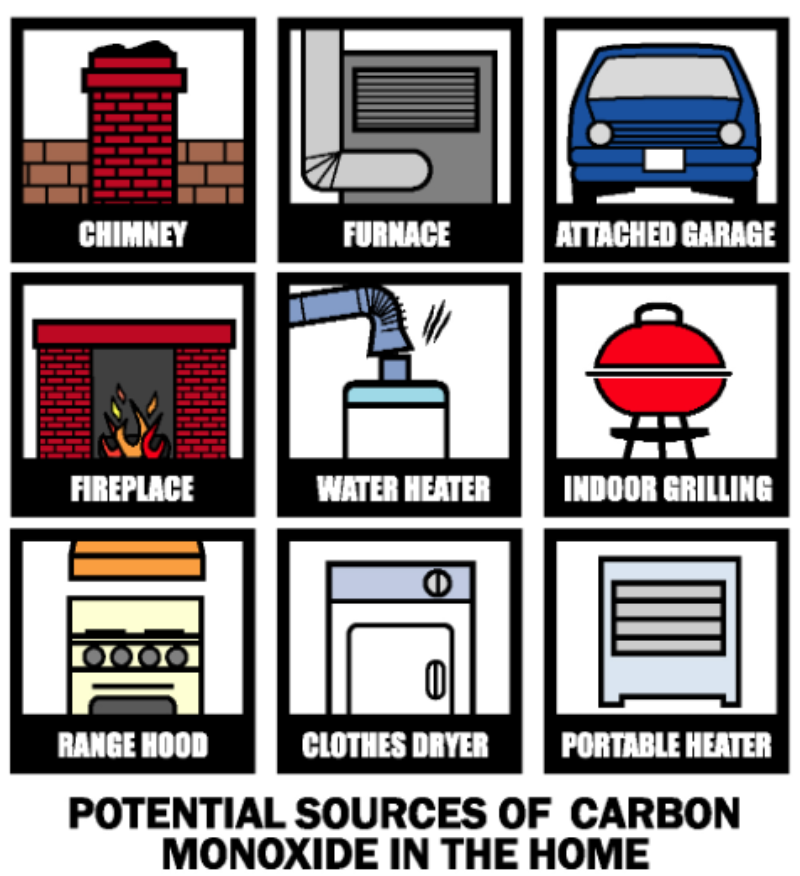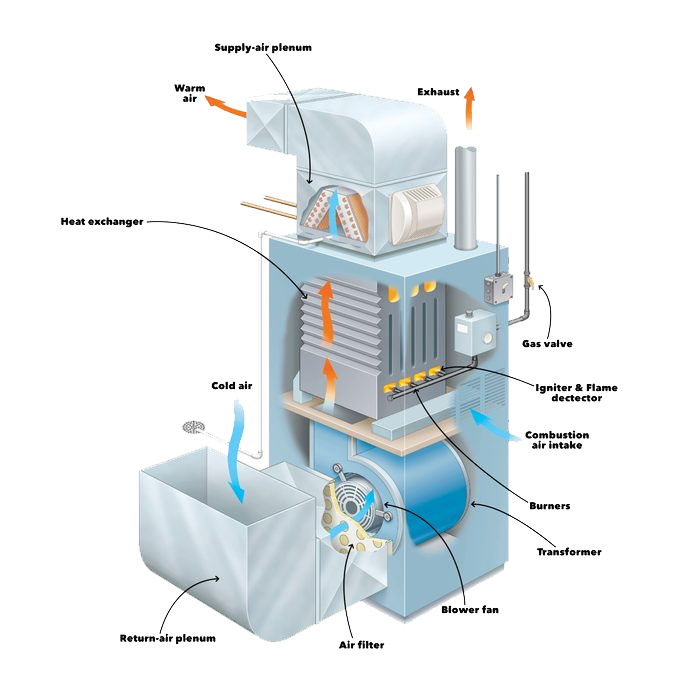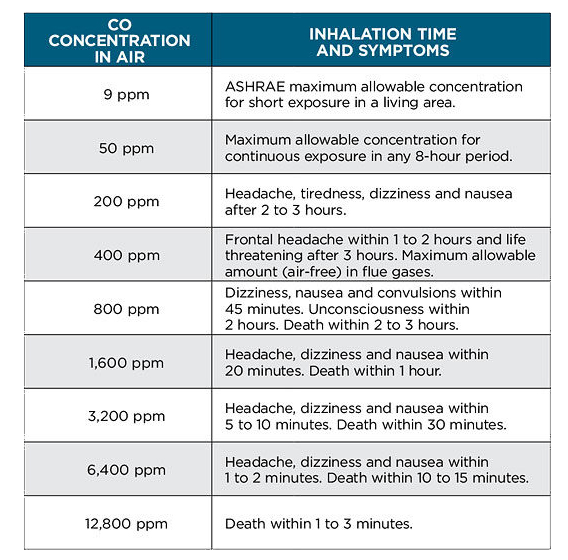
Understanding carbon monoxide, how it’s produced, and the symptoms of carbon monoxide poisoning could be the difference between life and death for you and your family.
Table of Contents
ToggleWhat is Carbon Monoxide?
Carbon monoxide (CO) is a harmful gas that can’t be seen, smelled, or tasted when it’s present in the air. When inhaled, carbon monoxide binds with the hemoglobin protein in our red blood cells that’s responsible for carrying oxygen to the rest of our body. When the two combine, they form a compound called carboxyhemoglobin, which reduces the amount of oxygen transferred through our red blood cells. This decrease in oxygen can cause symptoms such as headaches, dizziness, weakness, nausea, confusion, and in severe cases, death.
How Carbon Monoxide is Produced
Carbon Monoxide is produced when there is an incomplete combustion of a fuel source like coal, oil, kerosene, propane, or natural gas. Incomplete combustion occurs when there isn’t enough oxygen present for the fuel to burn completely, resulting in the production of carbon monoxide instead of carbon dioxide (CO2), which is harmless. It can also be produced from wood or charcoal in poorly ventilated areas.
When there is incomplete combustion, there are a few things you’ll start to notice in and around your appliance:
- A Yellow Flame
- Soot
- Condensation
If unnoticed, this will eventually fill the area with carbon monoxide and start affecting the way you feel.
Sources of Carbon Monoxide
Carbon Monoxide can be released from common household appliances, as well as from natural sources. Knowing where CO comes from helps to prevent exposure and ensures your safety. Below are some of the primary sources of CO:
- Gas Water Heaters: If a gas water heater isn’t vented correctly or doesn’t have enough fresh air, it will lead to incomplete combustion. releasing CO into the home.
- Furnaces: Both gas and oil-fired furnaces can produce carbon monoxide as a by-product of their operation. Poorly maintained, damaged, or improperly vented furnaces are common sources of CO buildup indoors.
- Gas Range: A gas range (or gas stove), cooktop, or oven has the potential to emit carbon monoxide when used without a properly working hood or down-draft system that vents outdoors.
- Fireplaces: Both wood-burning and gas fireplaces are potential sources of CO. Incomplete combustion can occur in wood-burning fireplaces if the wood is damp or the airflow is restricted. Gas fireplaces can produce CO if the flame is not burning cleanly or if the venting is blocked.
- Grills: Charcoal and gas grills produce carbon monoxide as part of their combustion process. Using these grills indoors, in garages, or in other poorly ventilated spaces can lead to dangerous CO levels.
- Portable Generators: These are significant sources of CO and can be deadly if used indoors or too close to windows, doors, and vents.
- Blocked Vent Pipe: Appliances that vent to the outdoors can backdraft CO into the home if the vents are blocked with debris or damaged.
- Vehicles: Cars, trucks, motorcycles, and any other vehicles with internal combustion engines produce carbon monoxide. Running a vehicle in an enclosed space, like a garage, can quickly lead to a build-up of CO to hazardous levels.

The Importance of Fresh Air and Correct Installation
One of the most common ways carbon monoxide becomes present in a home is when appliances aren’t installed correctly. This can be caused by a gas appliance that was installed in too small of a space without enough fresh air makeup or if the appliance isn’t vented properly.
Gas Appliances in a Confined Space
Each gas appliance requires a certain amount of fresh air to combust properly. Most gas appliances require 50 cubic feet of air per 1,000 BTUs of the total appliances in the room. However, you can find your appliance’s required space by looking in its manual. You can also calculate it yourself since the amount of fresh air available in a room is determined by its size.
Here’s a quick explanation of how to calculate if a room has enough combustion air with an example calculation using a natural gas tank water heater:
1. Add the total BTU load of all the gas appliances within the space.
Natural Gas Tank Water Heater – 40,000 BTUs
2. Determine the cubic feet of air required in the space.
Total BTUs
_______________ x 50
1,000
40,000 / 1000 x 50 = 2,000 cubic feet of air required
3. Measure the length, width, and height of the room to calculate its volume in cubic feet.
Room size: Length: 18’, Width: 15’, Height: 8’
18 x 15 x 8 = 2,160 cubic feet of air
In this scenario, the room is large enough to provide enough fresh air for the water heater to work properly and safely. If the amount of fresh air available in a given space is less than what a gas appliance requires for combustion, then that space is considered to be confined.
If a room is confined, air from another space must be brought in from outside the home or from another room through louvered grilles.
This involves creating two permanent openings: one within 12 inches of the ceiling and another within 12 inches of the floor. The size of these openings depends on the appliance’s BTU/h rating and whether the air is coming from indoors or outdoors.
Other gas appliances don’t require a vent as they can use the fresh air inside a well-ventilated room that’s large enough. These appliances are commonly referred to as “vent-free”.
Even though these appliances still produce combustion pollutants, the total fresh air and ventilation of the room will dilute and remove the contaminants from the appliance to avoid any health risks.
Venting Gas Appliances
Some gas appliances like furnaces and tank or tankless water heaters, are designed to use a direct-vent system that supplies the appliance with fresh air from outside and sends the exhaust out in a second chamber within the same pipe.
This eliminates the need to draw fresh air from the space where the gas appliance is located. While direct-vent systems are helpful in solving combustion air problems, it’s important to keep them clear of debris or any other obstructions outside.
Any type of blockage can lead to a negative pressure on your system, which will allow the exhaust or “flue-gas” and carbon monoxide to flow back down the vent pipe and into your home. Carbon monoxide can also be released if the vent pipe is not securely attached to the appliance.
Cracked Heat Exchangers
Heat exchangers are an essential component of gas furnaces. They work by transferring heat from one area to another. When the gas burner is on, hot flue gas is produced, which passes through the heat exchanger and heats up the outer metal walls.
This process continues as long as the furnace is running and the hot flue gas is released outside through the vent. Meanwhile, the furnace circulates fresh air around the heat exchanger, which increases the air temperature and eventually pushes it through the ductwork into your home.

However, if your furnace doesn’t have enough fresh air, the heat exchanger will overheat and eventually crack due to heat stress. When there’s a crack in your heat exchanger, the flue gas that’s supposed to be released outside can seep through the crack and mix with the air going into your home, resulting in carbon monoxide coming out of your vents.
Carbon Monoxide Poisoning and Symptoms
The symptoms of carbon monoxide poisoning will depend on how long you’ve been exposed to it and the parts per million (ppm) of carbon monoxide in the air. The most common symptoms include headaches, fatigue, shortness of breath, confusion, blurry vision, and nausea or vomiting.
The chart below shows what kind of carbon monoxide poisoning symptoms you can expect over different exposure times. As you can see, the longer you are exposed to it, the worse your symptoms will be.
If you start to experience any of these symptoms, you should walk outside and call 911 immediately. The emergency response team will have the correct instruments needed to detect carbon monoxide inside your home and which appliance is producing it.

How to Protect Yourself Against Carbon Monoxide Poisoning
The best way to protect you and your family from getting carbon monoxide poisoning is by installing carbon monoxide detectors. Carbon monoxide detectors are designed to sound an alarm based on how many PPM are in your home during a certain amount of time.
For instance, if there is a low level (50 ppm) of carbon monoxide present, it could take up to 8 hours to sound the alarm. However, if there is a higher level (150 ppm) of carbon monoxide present, it will sound the alarm within minutes.
What to do if a Carbon Monoxide Alarm Goes Off?
If your carbon monoxide alarm goes off, evacuate everyone from the home. Don’t assume it’s a false alarm. Once everone is outside, dial 911 or your local gas company. Let them know your CO alarm went off and if anyone with you is experiencing symptoms of carbon monoxide poisoning.
Don’t go back into your home for anything until it’s been checked and cleared by professionals. Once the source is found, make sure to schedule a licensed contractor to come out and see if any repairs can be made or if the appliance needs to be replaced.
If you use gas appliances in your home and you don’t have a CO detector, get one.
In most states, carbon monoxide detectors are required to be installed in structures that have gas appliances. But even if they’re not required to be installed in your state, it’s recommended to have one installed within 10 feet of every bedroom in your home.
This is so they can be heard if you’re sleeping, as that is the most dangerous time to be exposed to carbon monoxide. You can also have these installed in your living areas so you’re aware of any problems before they become dangerous.
There are also combination smoke and carbon monoxide detectors you can purchase to save wall space. Many home security companies also offer the same type of combination alarm that’s tied into their system so they’re notified of any issues at the same time you are.
Another way to prevent carbon monoxide poisoning is to have your gas appliances routinely checked and maintained by a licensed technician once a year. Yearly checks will help you catch any small issues before they become larger, more dangerous issues down the road.
Final Thoughts
It’s essential for everyone to learn about carbon monoxide (CO) and its dangers, particularly if you use gas appliances. CO can sneak up on us in places where we feel safe, like our homes, from everyday things such as heating systems, stoves, and even cars.
You can protect yourself and your loved ones by understanding how CO is produced, identifying potential sources, and implementing safety practices.
Simple actions, like checking the flames in gas appliances and noticing any soot or condensation around the appliance, can provide early warning signs of CO production. If you’re unsure or something seems off, it’s best to call a licensed professional to come and inspect.
Additionally, adding carbon monoxide detectors in your home offers a second line of defense against CO poisoning that works day and night.
Now that you understand carbon monoxide share your knowledge with others to raise awareness about this dangerous gas known as the “silent killer”. Always prioritize safety and stay informed, vigilant, and prepared.
- All
- Appliance Maintenance and Care
- Energy and Environmental
- How-to Guides
- Product Reviews
- Resources
- Safety and Health

After comparing different recirculating pumps available today, here are our picks for the best hot water recirculating pumps for residential homes.

HVAC stands for Heating (H), Ventilation (V), and Air Conditioning (AC). Together, these elements make up the complete HVAC system.

Finding your hot water heater leaking can be stressful, especially since you rely on it daily. Learn what to do immediately once you spot a leak.

How often you should change HVAC filters depends on the filter type, your home size, and usage. Find out when to replace them and tips to extend filter life.